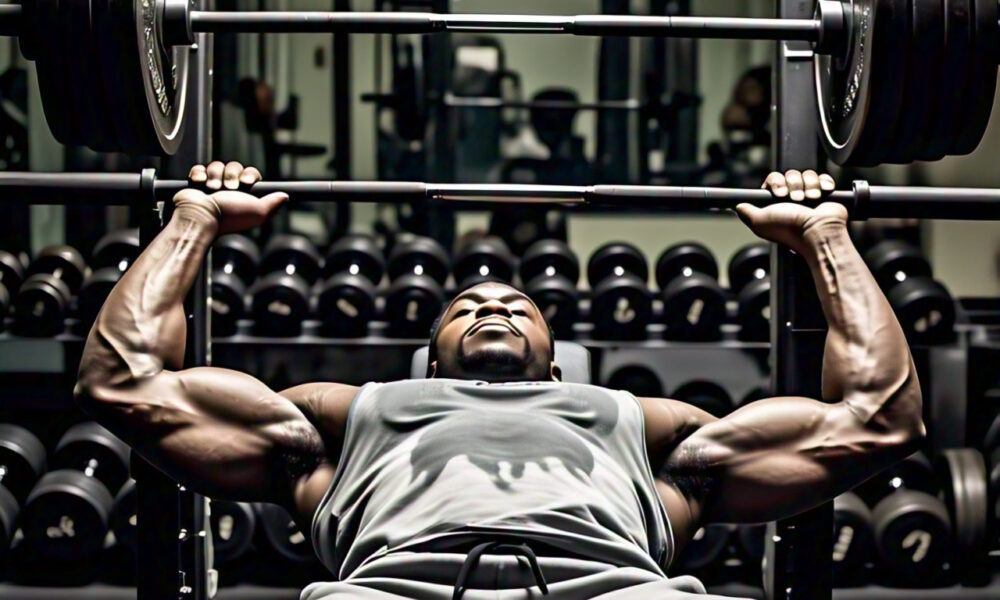The bench press is a fundamental exercise for building chest strength and development. It’s a compound exercise that targets multiple muscle groups, making it a staple in many weightlifting routines. However, performing the bench press with proper form and technique is crucial for maximizing its benefits and minimizing the risk of injury.
Preview of Key Takeaways
In this post, we’ll delve into the world of bench pressing and provide you with a comprehensive guide on how to perform the perfect bench press for chest development. We’ll cover the benefits of the bench press, the muscles targeted, and provide tips on proper form and technique. By the end of this post, you’ll be equipped with the knowledge and skills necessary to take your bench press game to the next level.
Benefits of the Bench Press for Chest Development
Muscles Targeted by the Bench Press
The bench press is a compound exercise that targets multiple muscle groups, including:
Pectoralis major: The pectoralis major is the primary muscle targeted by the bench press. It’s responsible for movements such as pushing, lifting, and throwing.
Anterior deltoids: The anterior deltoids are secondary muscles targeted by the bench press. They assist in movements such as lifting and throwing.
Triceps: The triceps are also secondary muscles targeted by the bench press. They assist in movements such as extending the elbow joint.
Benefits of the Bench Press for Chest Development
The bench press offers numerous benefits for chest development, including:
Increased muscle mass: The bench press is an effective exercise for building muscle mass in the chest. By targeting the pectoralis major, you can increase muscle growth and development.
Increased strength: The bench press is also an effective exercise for building strength in the chest. By targeting the pectoralis major, you can increase muscular strength and endurance.
Improved athletic performance: A strong chest can improve athletic performance in sports and activities that involve pushing, lifting, and throwing. The bench press is an effective exercise for building the strength and endurance necessary for these activities.
By incorporating the bench press into your workout routine, you can experience these benefits and take your chest development to the next level.
Proper Form and Technique for the Bench Press
Setup and Positioning: The Foundation of a Perfect Bench Press
Proper setup and positioning are crucial for performing the bench press with proper form and technique. Here’s how to set up and position yourself for a perfect bench press:
Grip width: Grip the bar with your hands slightly wider than shoulder-width apart. This will help you maintain control and generate power throughout the exercise.
Foot placement: Place your feet flat on the ground, with your knees bent at a 90-degree angle. This will help you maintain stability and generate power throughout the exercise.
Body position: Lie on the bench with your back flat against the pad, and your shoulders squeezed together. This will help you maintain proper form and engage the correct muscles throughout the exercise.
Lowering the Bar: Control, Speed, and Range of Motion
Lowering the bar to the chest is a critical part of the bench press. Here’s how to do it with proper form and technique:
Control: Lower the bar to the chest under control, taking 2-3 seconds to complete the movement. Avoid letting the bar drop or bounce off your chest.
Speed: Lower the bar at a slow and deliberate speed, avoiding any jerky or sudden movements.
Range of motion: Lower the bar to the chest, allowing your elbows to flex to a 45-degree angle. Avoid letting your elbows flare out or your shoulders roll forward.
Pressing the Bar: Control, Speed, and Range of Motion
Pressing the bar upwards is the final part of the bench press. Here’s how to do it with proper form and technique:
Control: Press the bar upwards under control, taking 2-3 seconds to complete the movement. Avoid letting the bar jerk or bounce upwards.
Speed: Press the bar upwards at a slow and deliberate speed, avoiding any jerky or sudden movements.
Range of motion: Press the bar upwards until your arms are fully extended, avoiding any locking or hyperextension of the elbows.
Breathing and Core Engagement: The Key to Stability and Power
Proper breathing and core engagement are critical for maintaining stability and generating power throughout the bench press. Here’s how to do it:
Breathing: Take a deep breath in, filling your lungs completely, and then exhale slowly as you lower the bar to the chest. Inhale slowly as you press the bar upwards.
Core engagement: Engage your core muscles by drawing your belly button towards your spine. Maintain this engagement throughout the exercise, avoiding any relaxation or disengagement.
By following these tips and techniques, you can perform the bench press with proper form and technique, maximizing your workout and minimizing your risk of injury.
Common Mistakes to Avoid When Doing the Bench Press
Letting the Hips Lift: A Common Mistake That Can Throw Off Your Form
Letting the hips lift off the bench during the bench press is a common mistake that can throw off your form and put unnecessary strain on your lower back. Here’s why it happens and how to avoid it:
Why it happens: Letting the hips lift off the bench can happen when you’re using too much weight or not engaging your core muscles properly. It can also happen when you’re not focusing on squeezing your glutes and pushing your hips into the bench.
How to avoid it: To avoid letting your hips lift off the bench, focus on squeezing your glutes and pushing your hips into the bench throughout the exercise. Also, make sure to engage your core muscles by drawing your belly button towards your spine. Finally, use a weight that allows you to maintain proper form and control throughout the exercise.
Not Controlling the Weight: A Recipe for Disaster
Not controlling the weight during the bench press is a recipe for disaster. It can lead to injury, poor form, and a lack of progress in your workout. Here’s why it happens and how to avoid it:
Why it happens: Not controlling the weight can happen when you’re using too much weight or not focusing on slow and controlled movements. It can also happen when you’re not engaging your core muscles properly or not using your legs to help drive the movement.
How to avoid it: To avoid not controlling the weight, focus on using a weight that allows you to maintain proper form and control throughout the exercise. Also, focus on slow and controlled movements, taking 2-3 seconds to lower the weight and 2-3 seconds to press it back up. Finally, engage your core muscles by drawing your belly button towards your spine, and use your legs to help drive the movement.
Not Engaging the Core: A Mistake That Can Lead to Poor Form and Injury
Not engaging the core during the bench press is a mistake that can lead to poor form and injury. Here’s why it happens and how to avoid it:
Why it happens: Not engaging the core can happen when you’re not focusing on drawing your belly button towards your spine or not using your core muscles to help stabilize your body. It can also happen when you’re using too much weight or not using proper form.
How to avoid it: To avoid not engaging the core, focus on drawing your belly button towards your spine throughout the exercise. Also, use your core muscles to help stabilize your body and maintain proper form. Finally, use a weight that allows you to maintain proper form and control throughout the exercise.
By avoiding these common mistakes, you can ensure that you’re getting the most out of your bench press workout while minimizing your risk of injury.
Variations of the Bench Press for Chest Development
Incline Bench Press: Targeting the Upper Chest Muscles
The incline bench press is a variation of the bench press that targets the upper chest muscles, particularly the clavicular head of the pectoralis major. Here’s how to perform the incline bench press:
Setup: Adjust the incline bench to a 30-45 degree angle. Lie on the bench with your back flat against the pad, and your shoulders squeezed together.
Grip: Grip the bar with your hands slightly wider than shoulder-width apart.
Movement: Lower the bar to your upper chest, then press it back up to the starting position.
The incline bench press offers several benefits for targeting the upper chest muscles, including:
Increased emphasis on the clavicular head: The incline bench press places more emphasis on the clavicular head of the pectoralis major, which can help to create a more balanced and developed chest.
Improved upper chest development: The incline bench press can help to improve upper chest development, which can be beneficial for athletes who participate in sports that require pushing or throwing motions.
Decline Bench Press: Targeting the Lower Chest Muscles
The decline bench press is a variation of the bench press that targets the lower chest muscles, particularly the sternal head of the pectoralis major. Here’s how to perform the decline bench press:
Setup: Adjust the decline bench to a 30-45 degree angle. Lie on the bench with your back flat against the pad, and your shoulders squeezed together.
Grip: Grip the bar with your hands slightly wider than shoulder-width apart.
Movement: Lower the bar to your lower chest, then press it back up to the starting position.
The decline bench press offers several benefits for targeting the lower chest muscles, including:
Increased emphasis on the sternal head: The decline bench press places more emphasis on the sternal head of the pectoralis major, which can help to create a more balanced and developed chest.
Improved lower chest development: The decline bench press can help to improve lower chest development, which can be beneficial for athletes who participate in sports that require pushing or throwing motions.
Dumbbell Bench Press: Targeting the Chest Muscles with a Different Range of Motion
The dumbbell bench press is a variation of the bench press that targets the chest muscles with a different range of motion. Here’s how to perform the dumbbell bench press:
Setup: Lie on a flat bench with your back flat against the pad, and your shoulders squeezed together.
Grip: Hold a dumbbell in each hand with your palms facing forward.
Movement: Lower the dumbbells to your chest, then press them back up to the starting position.
The dumbbell bench press offers several benefits for targeting the chest muscles with a different range of motion, including:
Increased range of motion: The dumbbell bench press allows for a greater range of motion than the traditional bench press, which can help to improve flexibility and mobility in the shoulders and chest.
Improved muscle recruitment: The dumbbell bench press requires more muscle recruitment than the traditional bench press, which can help to improve overall chest development.
Summary: Mastering the Bench Press for Chest Development
In this comprehensive guide, we’ve covered the key elements of the bench press, including proper form and technique, common mistakes to avoid, and variations of the exercise. By mastering the bench press, you can effectively target your chest muscles, improve your overall upper body strength, and enhance your athletic performance.
Key Takeaways:
Proper form and technique: Maintain a flat back, engage your core, and lower the bar to your chest with control.
Common mistakes to avoid: Avoid letting your hips lift, not controlling the weight, and not engaging your core.
Variations of the bench press: Incorporate the incline bench press, decline bench press, and dumbbell bench press to target different areas of the chest muscles.




